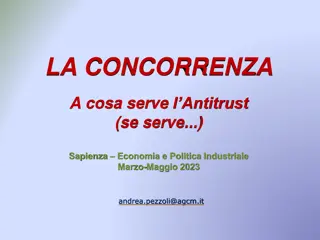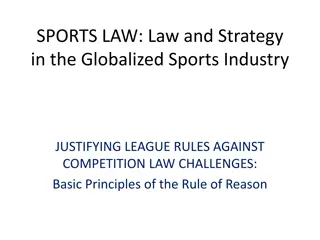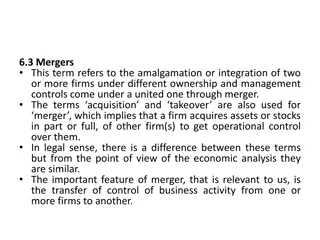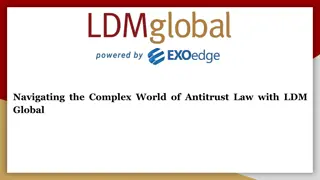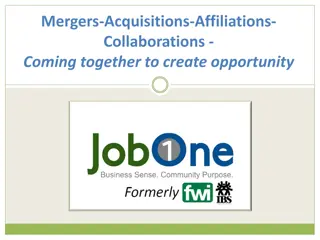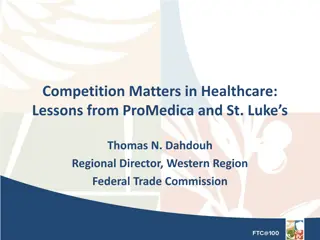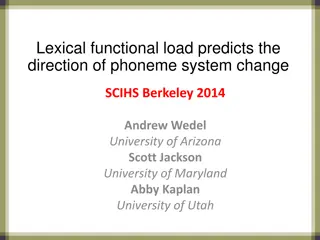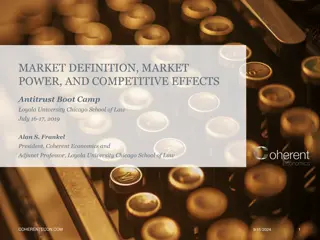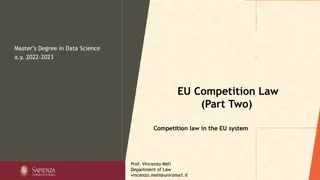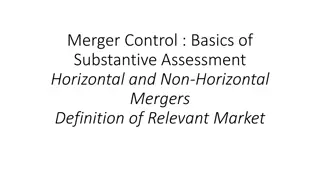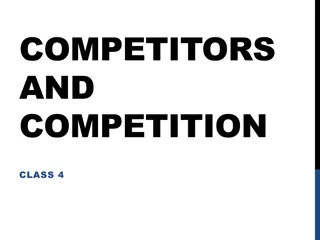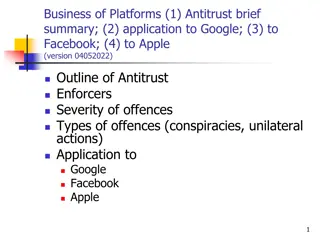Understanding Horizontal Mergers and Antitrust Laws
Explore the concept of horizontal mergers and various types of mergers like vertical and conglomerate with real-world examples. Learn about the impact of mergers on market dynamics, profitability, and reasons why firms merge. Dive into the interplay between antitrust laws and merger trends, uncovering the effects of mergers on market power and efficiencies.
Download Presentation

Please find below an Image/Link to download the presentation.
The content on the website is provided AS IS for your information and personal use only. It may not be sold, licensed, or shared on other websites without obtaining consent from the author. Download presentation by click this link. If you encounter any issues during the download, it is possible that the publisher has removed the file from their server.
E N D
Presentation Transcript
Chapter 6 Horizontal Mergers
Horizontal merger: when some firms in the same market (that is, competitors) combine to form one company Vertical merger: when two firms with potential or actual buyer-seller relationships combine to form one company Conglomerate merger: a merger that is neither horizontal nor vertical Product extension merger: the combination of firms that sell noncompeting products but use related marketing channels or production processes Market extension merger: the joining of two firms selling the same product but in separate geographic markets Pure merger: merger between firms with no obvious relationships of any kind
Antitrust Laws and Merger Trends The interdependence between antitrust law and the trend of mergers in the United States The six U.S. merger waves 1) Merger for monopoly 2) Mergers to oligopoly 3) Conglomerate merger 4) The rise in the annual value of acquisitions 5) The volume of acquisitions in this wave exceeded that of even the first wave 6) International wave that was cut short by the 2008 world financial crisis
The Effects of Horizontal Mergers It is generally believed that mergers take place because they are profitable Higher profit can come from two general sources: market power and efficiencies
Why Firms Merge Unilateral effect: when a merged firm, acting on its own, reduces output and raises price Coordinated effect: when a merged firm raises price in conjunction with rival firms by engaging in some form of collusion
Why Firms Merge Market power Review the analysis of the unilateral effect of a merger on a price by using the Cournot model from chapter 4 Collusion is intended to raise the price-cost margin above the competitive level Coordination is generally recognized to be easier when fewer firms are involved
Why Firms Merge Efficiencies The virtuous side to a merger is that greater efficiencies are reflected in lower costs as well as better products, more innovation, etc. Two broad categories of cost savings: pecuniary and real A merged firm can coordinate output across plants so as to reduce total cost A more efficient allocation of production cannot lower prices even when the merged firm optimally adjusts its total quantity, but a merger can have economies of scope by combining product lines or production processes, which reduces costs and enhances productivity
Welfare Analysis The merit of a merger depends in part on the welfare criterion that is employed to evaluate mergers The welfare standard used in the U.S. is consumer surplus A merger for which the decrease in cost is comparable in size to the increase in price will always raise welfare Can we infer anything about the welfare effect of a proposed merger if competitors are challenging it?
Merger Law and Enforcement Merger Evaluation: Activity and Procedures Consider the government s role in evaluating prospective mergers Discuss the before and after strategies as to when competition policy with regard to mergers could be conducted Second Requests and remedies Agencies can approve a merger, or, in rare cases, a merger can be outright prohibited
Development of Merger Law and Policy Era of structural presumption Review the 1962 case Brown Shoe Company v. United States The structural presumption era
Development of Merger Law and Policy Rise of the Chicago school of antitrust and the merger guidelines What was so striking about the structural presumption era is not just that mergers involving relatively low market shares were prohibited but that other evidence suggesting the market would remain highly competitive could rarely rebut it Consider the Supreme Court s 1974 decision in the United States v. General Dynamics Corp. case
Practices for Evaluating a Merger Market definition and the SSNIP test The 1982 Merger Guidelines The SSNIP test Market power is a continuous variable there is no magical way to determine a market without incorporating some standard The ultimate problem with market definition is that it defines a firm as in or out when the reality is more subtle
Practices for Evaluating a Merger Upward pricing pressure Consider the market competition between Proctor & Gamble s Crest and Colgate- Palmolive s Colgate that has existed since 1953 Vocabulary Diversion ratio The price-cost margin The upward pricing pressure (UPP) UPP is part of the 2010 Merger Guidelines and has been used as an initial screen to assess whether there might be significant unilateral effects
Practices for Evaluating a Merger Methods for estimating postmerger prices UPP is a useful screen for identifying points of concern warranting a more extensive analysis The market comparison method uses premerger markets to predict what the postmerger environment would look like Merger stimulation: the second approach to estimating the impact of a merger on prices
Practices for Evaluating a Merger Coordinated effects Coordinated effects can be relevant when a market has conditions conducive to collusion or has experienced or attempted collusion in the past Consider the first case in which the EC objected to a merger on grounds of coordinated effects (or collective dominance ) involving the French bottled water market
Practices for Evaluating a Merger Entry conditions Even when there is the prospect of unilateral or coordinated effects, a merger could be approved because it is believed that the threat of entry will either deter price increases, or if it did not, entry would occur to drive price back down Entry considerations can also provide a rationale for prohibiting a merger between firms that are not competitors, on the grounds that the merger would eliminate a potential competitor and thereby make the market less competitive
International Issues One source of differences among many competition authorities that review and control mergers is the standard used to judge whether a merger ought to be approved or blocked For global companies, the abundance of competition laws means having to gain the approval of multiple competition authorities when seeking to merge Consider the proposed purchase of McDonnell Douglas (MD) by Boeing in 1996
Summary This chapter covered the incentives to merge, how such mergers may impact social welfare, and the policy challenges faced when analyzing them Also discussed was the evolution of antitrust law and policy, merger policy, and the economic methods for measuring the unilateral effects of a merger



